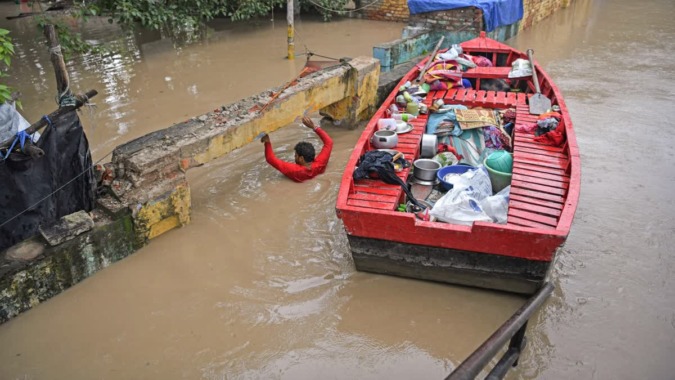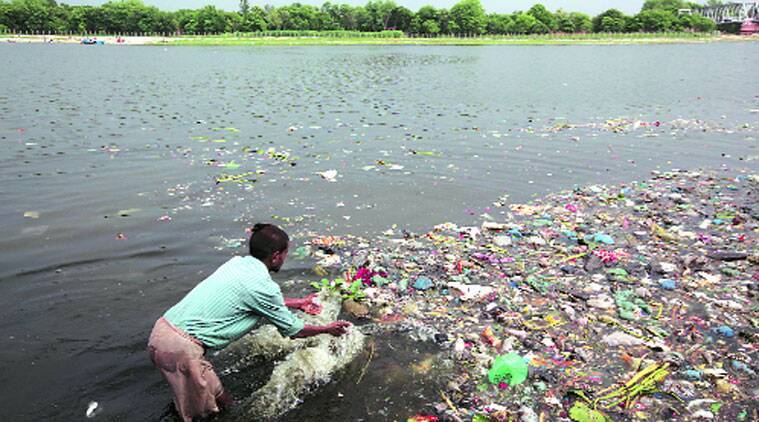
Several areas in Delhi, including Yamuna floodplains, along with low-lying areas of Civil Lines and Kashmere Gate, are currently experiencing severe flooding due to the swelling of the river.
The water level at the Old Delhi Railway Bridge has risen to 208.65 meters, surpassing the danger mark by 3.32 meters.
This unprecedented flood level has shattered a 45-year-old record, previously set at 207.49 meters.
In Delhi, the Yamuna River water level is measured at Old Delhi Railway Bridge and the information is fed in real-time on the flood alert portal of the Central Water Commission.
The Yamuna River, one of India’s most important water bodies, plays a significant role in the ecological, cultural, and economic aspects of the region. However, over the years, the water level of the Yamuna has become a cause for concern.
Rising pollution, encroachment, and unsustainable water management practices have led to a gradual decline in the river’s water level, posing serious threats to the surrounding ecosystems and human well-being.
In this article, we will delve into the factors contributing to the declining water level of the Yamuna and discuss the potential implications for environmental sustainability.
Pollution and Contamination

The Yamuna River faces severe pollution due to industrial waste, untreated sewage, and agricultural runoff. These pollutants not only degrade the water quality but also affect the river’s ability to retain water.
Contamination reduces the oxygen levels and disrupts the natural balance of aquatic ecosystems, adversely impacting the flora and fauna dependent on the river.
Encroachment and Diversion
Rapid urbanization and encroachment of the riverbanks have significantly reduced the Yamuna’s width and storage capacity. Construction activities, illegal settlements, and unauthorized sand mining further exacerbate the problem, impeding the river’s natural flow.
Additionally, water diversion for irrigation purposes and water supply to cities has further reduced the river’s volume, especially during dry seasons.
Climate Change and Deforestation
Climate change-induced factors like erratic rainfall patterns and increased evaporation rates contribute to the reduced water flow in the Yamuna. Deforestation and loss of green cover in the river’s catchment area also affect the river’s hydrological cycle, leading to decreased water retention in the soil and a subsequent decline in the river’s water level.
Implications for Environmental Sustainability
The declining water level of the Yamuna poses several significant implications for environmental sustainability:
- Ecosystem Disruption: Reduced water levels disrupt the river’s ecosystems, impacting aquatic plants, fish, and other species that rely on the Yamuna for their survival. The loss of biodiversity threatens the overall ecological balance and hampers the river’s regenerative capacity.
- Water Scarcity: As the Yamuna’s water level decreases, it directly affects the availability of water for agricultural irrigation, industrial processes, and domestic consumption. Water scarcity not only jeopardizes livelihoods but also intensifies conflicts over water resources among different stakeholders.
- Impact on Human Health: Contaminated water from the Yamuna poses severe health risks to communities relying on it for drinking water and daily activities. Waterborne diseases, such as cholera and typhoid, are rampant in areas where water pollution is high, contributing to a public health crisis.
- Economic Consequences: The declining water level affects industries dependent on the river, such as agriculture, tourism, and fishing. Reduced water flow and deteriorating water quality impact crop yields, tourism revenue, and livelihoods of fishing communities, leading to economic losses and social unrest.
Addressing the Issue:
Resolving the issue of declining water levels in the Yamuna requires concerted efforts from various stakeholders:
- Strict Pollution Control Measures: Industries and urban settlements along the riverbanks must adhere to stringent pollution control regulations. Implementing effective wastewater treatment systems and promoting sustainable industrial practices can help in curbing pollution.
- Restoration and Afforestation: Restoring the river’s catchment area by undertaking afforestation projects and implementing soil conservation measures can improve the water retention capacity of the Yamuna. Reforestation efforts should focus on promoting native plant species that are well-suited to the region’s ecology.
- Sustainable Water Management: Implementing sustainable water management practices, including rainwater harvesting, efficient irrigation techniques, and water recycling, can help reduce the pressure on Yamuna’s water resources and ensure equitable distribution.
- Public Awareness and Participation: Creating awareness among the public about the importance of preserving the Yamuna and encouraging community participation in conservation initiatives can foster a sense of responsibility toward the river’s well-being.
Conclusion
The declining water level of the Yamuna River demands immediate attention and collective action to safeguard the environmental sustainability of the region.
Combating pollution, preventing encroachment, and adopting sustainable water management practices are crucial steps toward restoring the river’s health. By preserving the Yamuna, we not only protect a vital natural resource but also ensure a sustainable future for generations to come.
Related posts:
- Black Lives Matter Since George Floyd – Our Take On This
- Personalizing Your Marketing Strategy and Boosting Your Brand
- How to Launch an Outdoor Marketing Campaign Using Nothing but Custom Yard Signs
- How To Become A Gloves Wholesale Supplier
- 1win Betting Site for India – Review On How to Register, Verificate, Get Bonus And Much More
- Factors to Consider When Running a Business





